NEPAL: April 2004
Nepal is a country that held many surprises for me. Most of my preconceptions
about the kingdom turned out to be way off the mark. I had envisaged
Nepal to be a tiny, mountain-locked country, sparsely populated by friendly,
homogeneously Tibetan, buddhist citizens concentrated in Kathmandu. Well...I
got the friendly part right. Otherwise, Nepal's geography ranges from
the Top of the World all the way down to tropical jungle. The 25 million+
Nepalis are overwhelmingly Hindu (>90%), live mostly in rural villages
and are segregated into ethnic regions that are stultifyingly different in
their appearance and customs. Nepalis always guess wrong in trying
to guess my origin, probably because they themselves are so ethnically diverse
that anybody from eastern, central or southern Asia could pass for a Nepali.
I think they just don't realize this. I am assumed to be Nepali, which
turned out to be very beneficial in cities where foreigners are charged a
relatively hefty entrance fee to enter certain touristic zones. If
I keep my mouth shut, keep my camera in my bag and walk purposely, then I
am Nepali. Never did I have this cover of anonymity in India. I
was told again and again by local people that they thought I was a Nepali
at first.
Seeing Nepal and India back to back underlined the stark contrasts between
the nations. Nepal is much cleaner and tidier than India. I saw
shopkeepers cleaning the streets in front of their stores, something I never
saw in India. There are very few hustlers or touts in Nepal. Nepali
merchants adapt their products and services to the needs and wants of their
clients, which was almost never the case in India. Nepali kids actually
smile and don't grow up learning a contempt for foreigners, which is the
impression one gets in India. Nepalis are diffident and respect personal
privacy and space. When they do open up from their reserved shell,
I found them to be sincere and honest. Conversely, personal space
doesn't exist in India, where you are fair game to be grabbed, cajoled, sneered
at, pushed out of the way, or cheated. It seems clear why travellers
feel more comfortable in Nepal. But why are these countries so different
in so many ways? They share a religion, an Indian-dominated mass-media,
and poverty problems, and there is no geographical barrier between India
and Nepal along most of their shared border, like there is between Nepal
and Tibet (in the form of the Great Himalayan mountain range). Nepal
was closed to the outside world by the British forces for centuries, but effectively
so was much of India. It's still a conundrum to me and hopefully someone
can share some insight with me.
There is no railway in Nepal and all transportation in the country flows
through essentially two principal east-west highways, linked by a critical
connector highway in abyssymal condition. The state of repair of buses
is considerably poorer than in India and the roads are comparable to the
worst roads in India (and I say that having ridden once in an Indian bus
that hit a pothole and flung me vertically 40 cm into the air, slamming my
head onto the steel overhead luggage rack). Some tourists seem to get
the impression that Nepal is wealthier than India, which I think is because
Nepalis are cleaner, calmer and don't act desperately or get in your face.
It is also the case that the commercial Nepalis that one encounters
in tourist towns are much better off than the countryside peasants who never
see tourists. But it is a country that does indeed have desperate needs.
One newspaper article I read described a shift of some professional
working people into vegetable farming because it was fast becoming a more
lucrative career path.
The political stalemate between the apathetic, megalomaniac King (labelled
a modern day central Asian Nero by some), corrupt and bickering political
parties that never did anything to earn the public's trust when they had
power, and the brutishly violent and dogmatic Maoist rebellion, has tuned
out the average Nepali, who is stuck between a rock, a hard place and an
even harder place. It is a hopeless lose-lose-lose situation and there
doesn't appear to be any promising prospects for improvement in the near
future. One respected Nepali international diplomat has voiced fears
that the nation is on the verge of collapsing into a failed state, with eerie
parallels to Cambodia in 1975, where a radically indoctrinated military managed
to usurp control of a peace-loving kingdom from an impotent and ineffectual
quasi-democratic central government, leading to indescribable horrors. On
the ground, these problems hardly affect the tourist at all, and Nepalis
of all persuasions are very careful about protecting tourism, as it is the
second largest source of income in the country after foreign aid. They
are grateful to have tourists, and fight their civil war behind velvet drapes
shielding tourists from the fear and uncertainty in their hearts.
No tourist has been killed during the many years of low-level conflict. Maoists
are known to collect an arbitrary "donation" from tourists on popular trekking
trails that they control, but they hadn't been seen on the trails that I
took for several weeks. Government military roadblocks stop all buses
along key points of highways and at entrances to cities, to search for Maoists
and their arms caches. This tends to delay transit times considerably
but cause no further inconvenience. Rock throwing confrontations between
protesters and government troops occur frequently and regularly in Kathmandu,
but never in the tourist districts of Thamel or Durbar Square. To
many tourists, Nepal appears to be a peaceful, happy, friendly Asian alpine
paradise; and that's how Nepalis would like you to see it.
PART 5: YAK YAK YETI
The spring trekking season in the Annapurna region peaks in March and
by late April, the rainy season approaches and visibility tends to diminish,
so I made trekking my first priority in Nepal upon arrival in the 2nd week
of April. The western hub city of Pokhara is second only to Kathmandu
in tourist traffic, and I found the Lakeside tourist ghetto to be surprisingly
clean and modern and completely adapted to western tourists. All signs
are in English and everybody speaks good English, even better than in Indian
tourist cities though Nepal was never a British colony. Before entering
Nepal, I had some concerns about the availability of merchandise in the
country, but a quick glance up and down the main street quickly dispelled
that fear. Plentiful restaurants served up all manner of creative
dishes designed to imitate those from the tourists' native countries, and
some of these concoctions are more successful than others. Still,
they try hard to please and industriously make do with less than optimal
supplies. Though it is a comfortable place to kick back, Pokhara itself
is not a primary attraction. On clear days, the 7000m high mountainscape
of the Annapurna range is clearly visible from town, and beckons to hikers.
I had originally arrived in Pokhara intending to find other trekkers or
at least join up with a trekking group organized by a local agency to save
on the costs of a guide. After a couple of days of footwork, I soon
realized that this would be a difficult task because the peak time of the
spring trekking season had past and relatively few trekkers were in town,
and the few that were didn't want to do the Annapurna Sanctuary Trek, which
I had my heart set on. Unlike the more famous Annapurna Circuit trail which
goes around the Annapurna range, this trail leads straight up into the womb
of the Annapurna peaks, culminating in the Annapurna Base Camp (ABC) at 4100m
(13,500 ft). In a fairly short time, you get both the village life that
has made the Circuit so popular, combined with the in-your-face Himalayan
scenery that draw trekkers to the Everest Base Camp trail. So not finding
any suitable groups for the Annapurna Sanctuary and not wanting to linger
any longer in Pokhara, I set out alone with no guide and no porter. Pokhara
natives assured me that there were no safety issues, the trails were well
marked, and that there were always plenty of trekkers on the trail on any
given day. All of this turned out to be quite true. Each day I joined
up with one of many different groups and got to meet just about everybody
along the route. The advantage of this method was that I was free
to go at my own pace, make detours or stops as desired, choose my own lodges,
and not have any set timetable.
On day 2 of the ascent, I veered off on a wrong trail thanks to not having
a guide, and found myself in the middle of what turned out to be a Nepali
New Year's (April 13 this year) party in a village gathering place not far
from Chomrong. The villagers warmly welcomed me to join them, which
I did for a few hours. They offered me tea and soft drinks and eventually
even sat me down at the table of village elders and leaders at the back
of the makeshift party tent, with the best view of the Nepali dancers that
later took the stage. A couple of the villagers spoke English and
cordially chatted with me, but overall, the trademark Nepali privacy prevailed
and I was left to savour the atmosphere of the festivities as an invisible
outside observer. The open warmth of their reception, without any
pretense nor attempt to benefit from me, invigorated me and gave me a wonderful
first impression of Nepali life. That a backpacking foreigner could
be seamlessly slipped into an intimate local gathering, off of the main trekking
route, without even the slightest hint of disruption is the most compelling
testament to Nepali culture (or at least ethnic Gurung culture) that I could
cite.
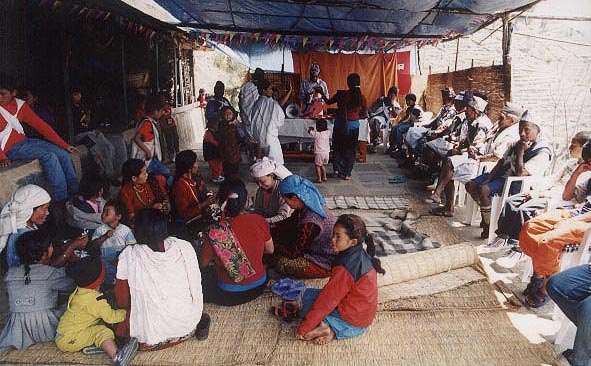
The party tent of the Taolu village New Year's party comprised
of a circle of women weaving flower garlands for the evening festivities,
onlookers seated on the side, and the table of village elders at the back
of the hall.
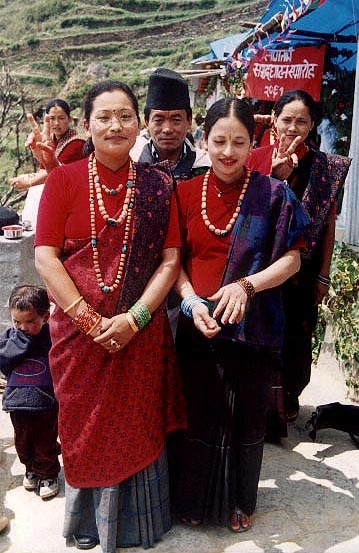
Taolu villagers model the latest in Nepali traditional costumes
After the first couple of days of climbing the steep ups and downs of Nepali
trails, your legs and lungs start to get used to the routine, and so I found
the last two days of the 4 day ascent up to ABC quite a bit easier than
the first two days, though more elevation is gained and the air is thinner.
Altitude problems didn't seem to affect any trekker that I had met,
though one fellow suffered mightily from a parasite infection in his gut.
On day three, we were pelted by a vicious hailstorm the likes of which
I had never seen. A torrent of almost grape sized stones accumulated
quickly and blanketed the ground with a 5 cm deep white layer in a matter
of 20 minutes. The rest of the day proved to be a cold and wet experience,
as I didn't have the time or foresight to waterproof my hiking shoes before
starting the trek. From that day forward, precipitation would fall
every afternoon starting around 2 pm in the afternoon, though mornings were
usually clear and sunny. An early start to the day helps considerably
in covering ground. On the last day of the ascent, we arrived
in the Annapurna Sanctuary, a pocket enclosed 360° around by the snowy
peaks of the Annapurna. It is a breathtaking gem of alpine panoramic
scenery that held each and every trekker in its enthrall.
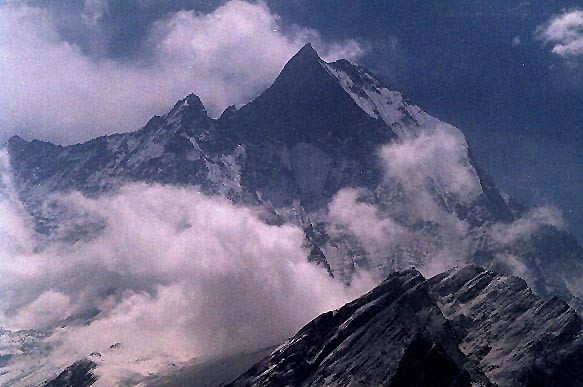
The Machhapuchhare (FishTail) mountain is the smallest of the great
Annapurna peaks at just a shade under 7000m, but its distinctive, aesthetic
form and its proximity to the trekking trail and to Pokhara confer an allure
and legend that is unsurpassed. As viewed from the Machhapuchhare
Base Camp inside the Annapurna Sanctuary.
Shortly after we arrived at the ABC around noon, a thick whiteout cloud
rolled into the camp, but we learned from those who had stayed the previous
night at the camp that there had been no visibility at dawn either, and so
they decided to stick it out another night. Life inside the lodges is
convivial and social, with trekkers, guides, porters, and staff all mingling
around a large heated table in the dining room. In the near freezing
temperatures, few choose to stay in their unheated rooms, and so every night
is a little party in the dining room. The food at all of the lodges
along the trail was surprisingly tasty and as it turned out later, better
than what was served at tourist restaurants in Kathmandu, in my opinion. Or
maybe it just feels that way after a few hours of trekking! And the
meals are inexpensive considering that all supplies are carried from 2000m
up to 4000m by human porters after the last mule-accessible village of Chomrong.
I slept restlessly that night, perhaps in part due to altitude adjustments
and perhaps in part from excited anticipation. I woke up without the
help of an alarm at 5:15 am, when the darkness of the night beats its initial
retreat, and I stumbled outside into the crisp subfreezing predawn air.
Many others were already positioned on the viewing ridge waiting for
the sunrise, and nobody made a noise. The absolute cold, eerie stillness
of the ABC is a palpable feeling that one cannot forget. The last time
I had this feeling was over ten years ago in Montreal, when I went out in
the middle of the night in -20°C temperatures to play ice hockey
with friends on an outdoor rink and other pickup players joined in through
the night. The first dawn ray strikes the top of the Annapurna I peak,
one of the small handful of 8000m peaks in the world, lighting the tip with
an orange glow that slowly descended down its great massif. A few minutes
later, the first direct rays break out over the eastern peaks, illuminating
the Base Camp. This dawn ritual delivered by the Himalayan heavens
was one of the most awesome moments of natural beauty I have ever experienced.
In an ambitious manoeuvre to maximize my touring time in Nepal, I flashed
back down the trail and returned to Pokhara in two days, to complete the
trek in 6 days total. Most agencies advertise the Sanctuary trek as
an 8 to 10 day trek. My knees and thighs weren't very happy about my
strategy, but I did make it down without injury and was able to depart Pokhara
the following morning and move on to my next destination to recover and relax.
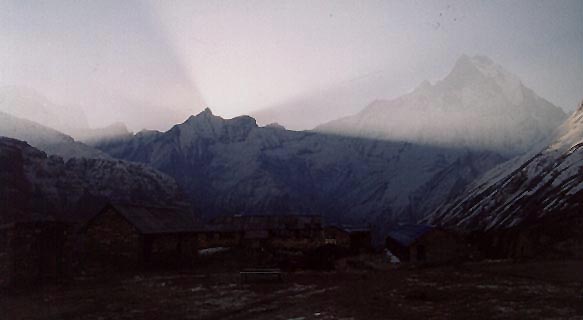
The first dawn rays break out over the eastern ridge, looming over
the Annapurna Base Camp.
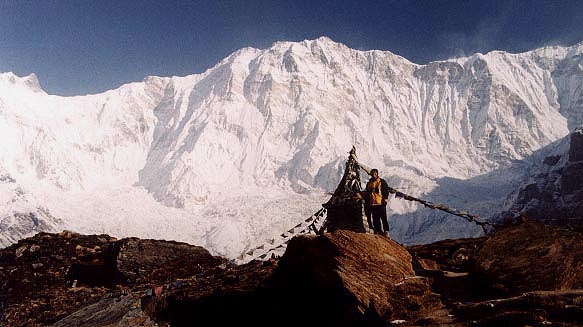
Standing at the Nepali prayer flags, commemorating the mountaineers
who died climbing the 8000m Annapurna I peak, pictured in the centre above
the stupa.
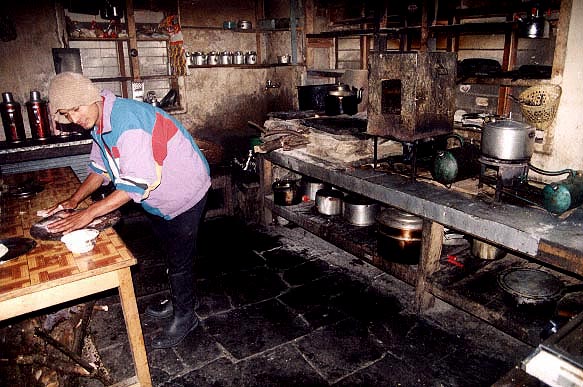
The cook at the Annapurna Sanctuary Lodge whips up dinner in the
lodge kitchen. Kerosene is the only energy source in the higher reaches
of the Annapurna trekking region.
BACK: PART 4 FEELING SIKH AND
BHANGED UP
NEXT: PART 6 KATHMANDU, NOT CONSTANTINOPLE





